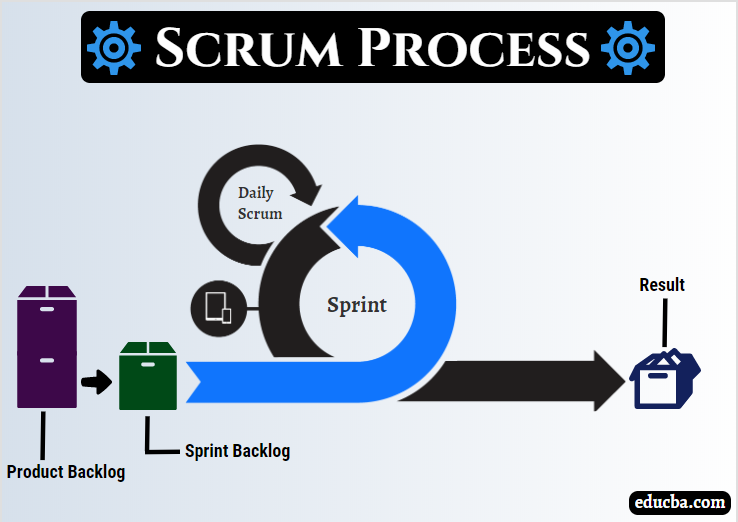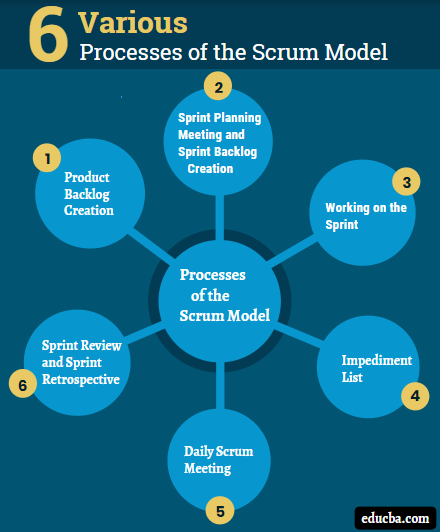
Overview of Scrum Process
Scrum, a simple framework of project management, was developed by Jeff Sutherland and Ken Schwaber. They represented the process at the Object-Oriented Programming, Systems, Language and Application conference in Austin, Texas, in 1995. Later they published the methodology as “Scrum Software Development Process.”
Framework of Scrum
Scrum emphasizes teamwork which influences team members to address complex problems and deliver the products with the highest possible value. Like a rugby team, Scrum instigates the team to learn through experiences and become self-organized when dealing with problems and improvement through reflecting on wins and losses. Generally, it is a framework for handling a project which focuses on teamwork, accountability, iterative progress toward achieving a well-defined goal.
Scrum is often assumed to be part of the agile software development process because the Scrum concept revolves around continuous improvement, which is a primary principle of agile. The framework begins with the simple acknowledgment that the team does not know about the details of every nook and corner of the project at the outset; rather, it is experienced by adapting to changing conditions and user requirements.
Key Roles in Scrum Framework
In the scrum framework, there are three key roles – product owner, scrum master, and development team- that are very important for the project’s success.
1. Product Owner
It plays the role of liaison between customers and the development team. He or she is the champion for their product. The product owner ensures that the expectation for the completed product has been communicated and agreed upon accordingly.
2. Scrum Masterworks
As a facilitator who is the champion of scrum within the team, it is the primary responsibility of the scrum master to assure for carrying out scrum best practices in the project. He or she schedules the needed resources for sprint planning, stand-up, sprint review, and the sprint retrospective.
3. The Development Team
Works together for developing and testing incremental releases of the final product. The team members are the champions for sustainable development practices. The usual scrum teams are five or seven members, tight-knit and co-located.
Various Processes of the Scrum Model
The scrum method consists of certain processes or the set of sequential events that the scrum team performs regularly. These are some crucial events where the teams play a part.
1. The Product Backlog Creation
The product owner takes part in product backlog creation. It is the primary responsibility of the product owner to take a constant view of market and customer needs, and that is why he or she has to drive the product by the product vision. He or she makes a list based on customers’ feedback, and the development team helps to prioritize the list to work at any given time. This is an ongoing process, and the changes or new emergence accept as new opportunities rather than obstacles.
2. Sprint Planning Meeting and Sprint Backlog Creation
Sprint planning meetings happen at the beginning of a project, and all the development team members have to participate in this meeting. This meeting is led by a scrum master, where the team members and the product owner decide the goal of the sprint. The duration of the sprint lasts only 2 weeks, but during that time, it is important to maintain cooperation between stakeholders and team members. The product owner regulates the importance of a proper user story, and the scrum team can choose a significant story from the product backlog. The specific user story should always be associated with the goal. At the end of the sprint planning meeting, every scrum member must have a clear idea of what can be brought in the current sprint and how the increments will be delivered.
The sprint backlog is the list of items, user stories or bug fixes chosen by the development team for application in the current sprint cycle. At the beginning of a sprint, the team decides what item they will choose from the product backlog to work in the sprint. As if sprint backlog is developed during the sprint, it is highly flexible. But the ultimate sprint goal has to be fixed.
3. Working on the Sprint
As the goal of the sprint is fixed at the sprint planning meeting, the scrum team begins work to deliver an increment. To track the current working progress, a task board is generally used.
4. The Impediment List
When the actual working process initiates, each team member can add impediments or blockers to a list of what he or she faces during working on the assigned task. As soon as the members announce or add the blockers to the list, the scrum master has to take the initiative to eliminate those blockers. When the blocker arises, it should be communicated to other team members in daily scrum meetings and keeping the record in the impediment list.
5. The Daily Scrum Meeting
The daily scrum meeting usually takes place at the same time to discuss the necessary task to reach the sprint goal. This informal meeting usually lasts 15 minutes, and the scrum master takes the initiative to make it happen daily. The purpose of the meeting is to keep each scrum team member in the same alignment and make a plan of work for the next 24 hours without compromising the goal. In this meeting, the team members usually keep focussing on three questions –
- What did I do yesterday to meet the sprint goal?
- What do I plan to do today to help the team to meet the sprint goal?
- Are there any obstacles that may avert the team to meet the sprint goal?
This is not an extensive discussion meeting, and it is also called ‘daily stand-up’.
6. Sprint Review and Sprint Retrospective
At the end of the sprint, the members meet together to demonstrate the backlog items to the stakeholders, teammates and product owner for feedback. After this, the product owner can decide whether the increment will be released or not.
In the sprint retrospective, the team members come together to share their experiences with what they have gained during the sprint. They discuss what went well and what needs to be improved in the next iteration.
Scrum is a framework that brings regularity to the project through its various phases or processes. Any organization can implement a scrum framework without altering its rules and regulation.
Recommended Articles
This is a guide to the Scrum Process. Here we discuss the Key Roles in Scrum Framework and Various Processes of the Scrum Model. You can also go through our other suggested articles to learn more –


